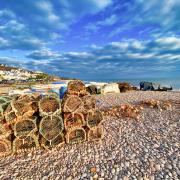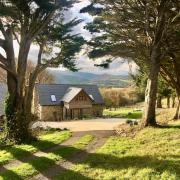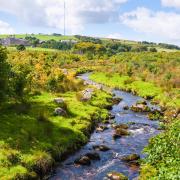With signs of spring on the way, it’s time for finishing off winter jobs and preparing for the year ahead at RHS Garden Rosemoor
When the days begin to lengthen and the sun shines a little stronger, then you know that spring’s not far away. I always feel that February is the turning point from winter to spring as I know that however bad the weather is now, it can only get better.
Throughout Rosemoor, snowdrops are working their charm along with early daffodils including species Narcissus in the meadows and our British native, N. psedonarcissus by the stream. I love to wander the Winter Garden to see how many variations of hellebore I can spot, delighting in their simple nodding flowers
from pure white to the darkest purple. These beauties are a source of pollen for bumblebees brave enough to emerge into the February sunshine.
Spidery Hammamelis, frothy Cornus mas, fragrant Daphne, purple crocuses
and pussy willows are just a few of the highlights in this month of frost and mists.
At Rosemoor we will be finishing off the winter jobs, such as winter pruning of
Wisteria on the Garden Room terrace, tidying them up before the growing season starts. The rose gardens are looking a little bare at the moment but now is the best time to prune and get some new varieties in the ground, including ‘Disco Queen’ and ‘Hot Chocolate’, followed by a feed and a good thick mulch to suppress weeds and reduce water loss. In the orchard, the edibles team are finishing off
winter pruning of the apple trees and soft fruit. The beds in the new greenhouse, installed at the end of last year, have been sown and the first crops of early salad
leaves have already emerged.
Scented Narcissus fills the space with a sweet perfume. Sowings of crops, including broad beans and brassicas are made in the nursery this month and shallots are started off in 9cm pots for an extra early display in the potager.
Here, we are busily replacing the woven willow edging around some of the beds to keep them looking smart.
At the beginning of the month, we welcome our new intake of allotment keepers who, under the guidance of the edibles team, will cultivate a patch of ground in
the Learning Centre. One of their first tasks is to put their potatoes to ‘chit’ giving them a head start before planting out in March.

In the ornamental gardens, snowdrops are being split after flowering and clumps replanted in the green at the end of the month, keeping them healthy and bulking up our displays throughout the garden. Where possible, deciduous grasses are left standing over winter to provide shelter for all manner of creatures including insects and small mammals. When the time comes to cut them down, we keep an eye out for the distinctive balls of woven grass that could be one of last year’s harvest mouse nests. Any finds are recorded for our own biodiversity monitoring
and for the Devon harvest mouse project run by the Devon Mammal Group.
To improve the habitat for wildlife, including dormice, we lay (referred to as steeping’ in Devon) as many of our native species hedgerows as we can in a season. This is the first year that volunteers from ‘Devon Birds’ would have carried out a February bird survey – it is too early for results yet but they should include winter visitors such as redwing and fieldfare.
Sheila is garden technical services officer at RHS Garden Rosemoor.

THE WINTER GARDEN
RHS Garden Rosemoor has many separate sections, or ‘gardens within the garden’. This month we look at the Winter Garden, with Geraldine King.
What makes the Winter Garden so special?
The Winter Garden brightens up a dull winter’s day. The range of autumn colour from the leaves on trees which then look like they are snowing when they fall off on a frosty morning. The variety of colour from the stems and trunks of trees and shrubs really dazzles in the low winter sun. And then there’s awakening of spring when the camellias and daphnes with their perfume, burst into flower. Rather excitingly we are embarking on rejuvenating our Winter Garden over the next 18 months. We will be adding to our existing multi-coloured stems, reshaping the lawns, opening up the view to the shelter and adding new shrubs, trees and bulbs to enhance the colour in the garden.
What’s looking good in the garden this month?
At Rosemoor we are responsible for the National Collection of Cornus and several can be viewed in our Winter Garden. They are renowned for their brightly coloured stems which are stunning right now. The bark from our three Acer griseum paperbark maple) peels away, enticing you to want caress the trunk. Then there’s the arrival of our snowdrops (Galanthus) of which several varieties can be found in this garden, adding a carpet of white underneath the spring flowering camellias.
Key jobs in the Winter Garden this month
Firstly, we want to allow people to enjoy all the colours the garden has to offer.
Towards the end of February we will coppice some of our Cornus to encourage new growth for next year. Then there’s formative pruning to various evergreen shrubs and trees, basically removing dead wood and shaping the shrubs and lifting branches on trees.
This is also the ideal month to look at the garden and start planning what to add to it for next year - placing orders with nurseries.



























